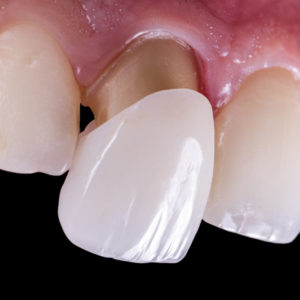Crown and Bridge

Tooth Crown and bridges serve as custom-fit caps to protect and restore teeth. Crown and bridges are not just temporary fixes; they’re long-lasting solutions. At Pulse Dental, we use modern digital technology to efficiently craft these crowns and bridges. This often allows us to offer same-day services for our patients. If you’re interested in getting top-quality dental care, give Pulse Dental a call today.
Tooth Crown
A tooth crown is a custom-made cap that covers a tooth, often for these key reasons:
Decayed Tooth: Large decays mean more tooth material is removed. This makes the tooth weaker and at risk for further damage or decay. A crown offers protection.
After Root Canal Treatment: Teeth become more fragile post-root canal. Crowns and bridges help prevent these teeth from breaking.
Cosmetic Enhancement: Crowns, which match the color of natural teeth, can be used to enhance the appearance, especially for front teeth.
Tooth Crown Process
Fabrication of a tooth crown involves multiple steps, preparing the tooth, taking an impression, making a temporary tooth crown, and finally inserting the crown.
Preparing a for a Tooth Crown
When preparing a tooth for a crown, the dentist delicately reshapes the tooth to create the necessary space for the crown to fit securely. This process is intricate, ensuring that only the required amount of tooth structure is removed without affecting adjacent teeth. At Pulse Dental, we prioritize precision and care to guarantee a seamless fit for your crown.
Taking Impressions for a Tooth Crown
The second step, after preparing a tooth for a crown, is taking an impression of the tooth. Traditionally, dentists would use impression materials, a process many find uncomfortable. At Pulse Dental, we employ digital technology to capture digital impressions without the need for traditional impression materials, offering greater accuracy and enhanced comfort for the patient.
Making a Temporary Tooth Crown
Usually it takes about week or two until the crown is fabricated by a dental lab. In the meantime, a temporary will be placed on the tooth to protect the tooth. At Pulse Dental, we fabricate your crown in the same appointment, which means you don’t need a temporary crown.
Placing the Final Tooth crown
The final step involves placing the permanent crown. At this stage, the dentist removes the temporary crown, positions the final crown, and thoroughly checks its fit and comfort. Once ensured that everything is in order, the crown is cemented in place using a biocompatible material.
Dental Bridge
Dental bridges consist of two or more crowns linked together. The main reasons for opting for dental bridges include:
Replacing a Missing Tooth: A dental bridge uses a prosthetic tooth attached to adjacent crowns to permanently replace a missing tooth.
Stabilizing Teeth: Sometimes, bridges are employed to stabilize loose teeth by anchoring them to the stable teeth adjacent to them.
Preventing Tooth Shifting: After tooth extraction, especially when there’s an empty space, a bridge can prevent neighboring teeth from shifting out of place.
Dental Bridge Process:
The procedure for placing a dental bridge mirrors that of a dental crown. It involves preparing the adjacent teeth, capturing an impression, crafting a temporary bridge, and ultimately setting the permanent bridge in place
Implant Vs Bridge
Dental Bridge
- Purpose: Replaces missing tooth
- Adjacent Teeth: Requires crowns on neighboring teeth
- Dependence: If a part of the bridge fails, the entire bridge can fail
- Bone Health: Bone loss can still occur beneath the bridge
- Treatment Duration: Approximately 2 weeks to complete
- Cost: Initial price may be lower than that of an implant
- Insurance: More insurance plans cover dental bridges compared to implants
Dental Implant
- Purpose: Replaces missing tooth without affecting adjacent teeth
- Adjacent Teeth: No need for crowns on neighboring teeth
- Dependence: Standalone; not dependent on adjacent teeth for support
- Bone Health: Helps in preserving jaw bone and can prevent bone loss
- Treatment Duration: can take several months due to healing time
- Cost: Initial price might be higher than that of a bridge
- Insurance: Fewer insurance plans may cover dental implants compared to bridges
Crown and Bridge cost
The typical cost for a crown in Houston, TX ranges between $700 and $1500. The cost of a bridge is generally calculated by multiplying the price of a single unit by the number of units required. Most insurance policies cover about 50% of these costs. If you don’t have insurance, Pulse Dental offers affordable payment plans to make your treatment more manageable.
FAQ
What are Tooth Crowns Made of?
Types of Dental Crowns and Their Pros & Cons:
1. All-metal Crowns (e.g., Gold)
- Pros: Strong, durable, less tooth removal, minimal wear to other teeth.
- Cons: Metallic look isn’t ideal for front teeth.
2. Porcelain-fused-to-metal (PFM) Crowns
- Pros: Tooth-colored surface.
- Cons: Can wear down or chip, possible dark line at the gum.
3. All-resin Crowns
- Pros: Cost-effective.
- Cons: Wear down quicker, more fracture-prone.
4. All-ceramic or All-porcelain Crowns
- Pros: Natural color match, good for metal allergies.
- Cons: Less strong, can wear other teeth.
5. Pressed Ceramic Crowns
- Pros: Hard core, aesthetic porcelain cap.
- Cons: Not as durable as others.
6. Zirconia Crowns
- Pros: Very strong, tooth-colored, less tooth removal.
- Cons: Might wear other teeth if not well-polished.
The ideal crown depends on tooth location, appearance needs, and budget. Always consult with a dentist for the best choice.
Can I have a front tooth crown?
Yes, when addressing a front tooth, aesthetics are a primary concern. However, thanks to advancements in technology and materials, achieving a natural-looking and well-functioning front tooth crown has become more straightforward.
What is a front tooth crown cost?
Generally, there isn’t a significant distinction between crowns for front teeth and those for back teeth in Houston, TX.
How much tooth is needed for a crown?
For a dental crown, typically 1-2 millimeters of the tooth’s surface is reduced on all sides. The exact amount can vary based on the crown material and the tooth’s condition.
My Crown fell off and my tooth is black, what should I do?
When something like this happens, you should see your dentist immediately. The dentist will evaluate the condition and will decide if the tooth is restorable or not.
My crown tooth is sensitive to cold?
If your crowned tooth is sensitive to cold, it could be due to a few reasons:
Post-procedure Sensitivity: It’s not uncommon to experience sensitivity after a crown placement. This usually subsides after a few days to weeks.
Exposed Dentin: If the gum line recedes slightly or the crown doesn’t cover the entire tooth, exposed dentin can result in sensitivity.
Poor Fit: If the crown doesn’t fit perfectly, it can leave gaps where bacteria can seep in, leading to sensitivity and potential decay.
Loose Crown: Over time, a crown can become loose, allowing bacteria to leak in and cause sensitivity or decay.
Pulpitis: Sometimes, the dental pulpcan get inflamed, causing sensitivity. This can be due to trauma during the crown prep or other reasons.
Referred Sensitivity: The discomfort may not actually be from the crowned tooth, but from neighboring teeth or gums.
If the sensitivity is persistent or painful, it’s essential to visit a dentist for a thorough evaluation and necessary adjustments or treatments.
Can a tooth under a crown decay?
Yes, a tooth under a crown can still get cavities. Here’s why:
- Edges of the Crown: If the crown’s edge doesn’t fit just right, bacteria can get in and cause decay.
- Chips or Cracks: If the crown gets damaged, bacteria can sneak under it and harm the tooth.
- Oral Care: Brushing and flossing are important, even with crowns, to keep the tooth healthy.
If you have pain or sensitivity around a crowned tooth, see your dentist to check for any issues.
Tooth pain under a crown comes and goes what should I do?
If you have on-and-off pain under a crown:
- Visit Your Dentist: They’ll check what’s causing the pain.
- Possible Reasons: Could be a cavity, gum issue, or a loose crown.
- For Relief: Use pain relievers and avoid very hot or cold foods.
- Keep It Clean: Keep brushing and flossing gently.
Don’t ignore the pain. It’s important to get it checked out.

